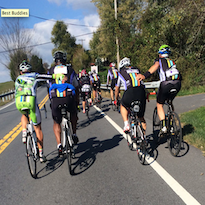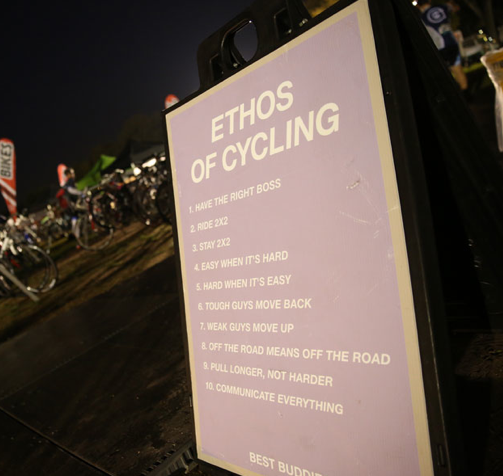Bicycling magazine posted an article about the Best Buddies charity ride in Washington, DC. The mission of Best Buddies is giving people with intellectual and developmental disabilities opportunities for friendship, employment, and a fulfilling life.
But the idea that the announcer of the ride, Buddy Fries, came up with to encourage and empower the less fit or newcomers to century rides to complete the event in less time (and not drop out) got me thinking how we can incorporate this idea into our cycling classes.
You can read the full article in Bicycling magazine here. Below is an excerpt.
For most of us, there’s something daunting about signing up for that first 100-mile ride. While the distance can be intimidating for anyone, less experienced cyclists may also worry that they’re going to spend the day alone and in pain.
Richard Fries wants to change that. As the announcer for the Best Buddies Challenge charity rides, he has seen firsthand how many people struggle to finish a long event, or get off the bike and vowed to never do it again.
To keep riders at the back of the pack motivated, Fries came up with an idea he calls “welding”: He recruited other strong cyclists to help shepherd the rear of the group to the finish and “weld” together any gaps. “We move to the very back of the field at the beginning of the ride, and then we slowly advance, riding two-by-two, and urging those we pass to get on our wheel,” Fries explained. “We roll in to the finish six hours after starting with dozens of beginners and novices who expected to finish in eight hours, and they are practically weeping for joy.”
Fries had two main tactics to keep the group together. First, he put the weaker riders up front and the stronger riders in the back, so that the slower riders could set the pace and have stronger riders behind them to help if they got into trouble. The second was to make the ride harder in places where cyclists tend to take it easy, but encourage riders to ease up on challenging terrain. This way the group could gain time on the flats and descents, but stay together when the road pitched upwards.
For many instructors, this method of empowering our “weaker” riders is what we aim to do in our cycling classes every time. But, it got me thinking about how we could incorporate this concept of being a buddy into our coaching. Here’s one idea I came up with…
Imagine you have a room full of riders of all abilities. Your profile is one that includes numerous hard climbs, some extended (longer than 10–12 minutes), at an intensity that will hover right around or just below threshold. (This won’t work as well for above-threshold short intervals—it works better with a long, mentally challenging effort.)
At the beginning of your ride, let everyone know that you are going to incorporate the “buddy system.” You can explain to them this system used at the Best Buddy Challenge rides and how it works. You will ask your riders to either be a “buddy” to someone, or to look for a buddy. They don’t need to tell anyone else, this can all be in their head, but the power of visualization is incredible and will work just as well as reality! Tell them this:
You know who you are! Some of you are super strong, others are fairly new and committed to working on your fitness, but realize sometimes you can use a little motivation. We are all going to work together—but this will be in your mind’s eye. You know if you are strong and fit and love pushing yourself; you know from experience that even when the going gets tough, you manage to do what it takes! For you guys, I want you to imagine that you are going to move to the back of the group with your bikes, pick one rider who looks like he or she is worried whether they will make it, perhaps slightly struggling. Imagine placing your hand on their backs. You don’t have to drop your intensity to “easy”—remember you’ll still be climbing. In your mind’s eye, picture yourself encouraging them. What would you say? How does it make you feel?
For those of you who struggle at times to complete the longer climbs or have doubts about your fitness, I want you to imagine that your best buddy is riding next to you, perhaps placing his or her hand on your back as encouragement. Again, you don’t need to physically do this; just imagine it. How does it feel? Listen to their words of encouragement, match their pedal stroke, know that you are not alone and that come hell or high water, YOU WILL FINISH THIS!
When you get to a particular challenging segment, you can repeat the above, directing them to imagine their role, either the buddy offering encouragement or the newer rider accepting the encouragement from their buddy.
I can picture this really working well in the final hour of a charity special event of multiple hours. You can project images of riders helping other riders, just like in the article.
I like the idea of using visualization instead of actually calling riders out as being a “buddy” or needing a “buddy” because that labels them as “advanced” or “beginner.” This way everyone can empower or be empowered, depending on their own self-classification. The less experienced won’t feel singled out, but will hopefully draw strength from the visual of someone riding next to them specifically encouraging them.
How about you? Do you have some ideas of how to incorporate a “buddy” ride into your classes? If so, please leave them in the comments!



Terrific ideas both of you! I have ridden beside friends on the road and placed my hand on their back. It is always appreciated. (Especially if it’s my wife I’m helping.)
I can see it working well in my class (mixed, beginners and regulars)
Thank you!
Thanks Haley! I loved your session at the Indoor Cycling Summit, and I know you addressed this concept in more detail in your session. What a great way to inspire riders to push for their best!
Great article Jennifer! If I could add an additional exercise that incorporates the buddy system. What I like to do when I teach (and what I present to fitness professionals on stage) is take a moment in class to ask everyone to look around and choose one person who looks the most energized, confident, OR strong (choose the word you like best that doesn’t focus on performance, but rather on effort). Then, ask your participants to match or beat that person’s energy, confidence, OR strength. What will happen is, some participants will choose a person to match and enhance their effort. The others will want to be picked and also enhance their effort to stand out. Either way, this is a great social support system that motivates everyone to raise their level of effort.